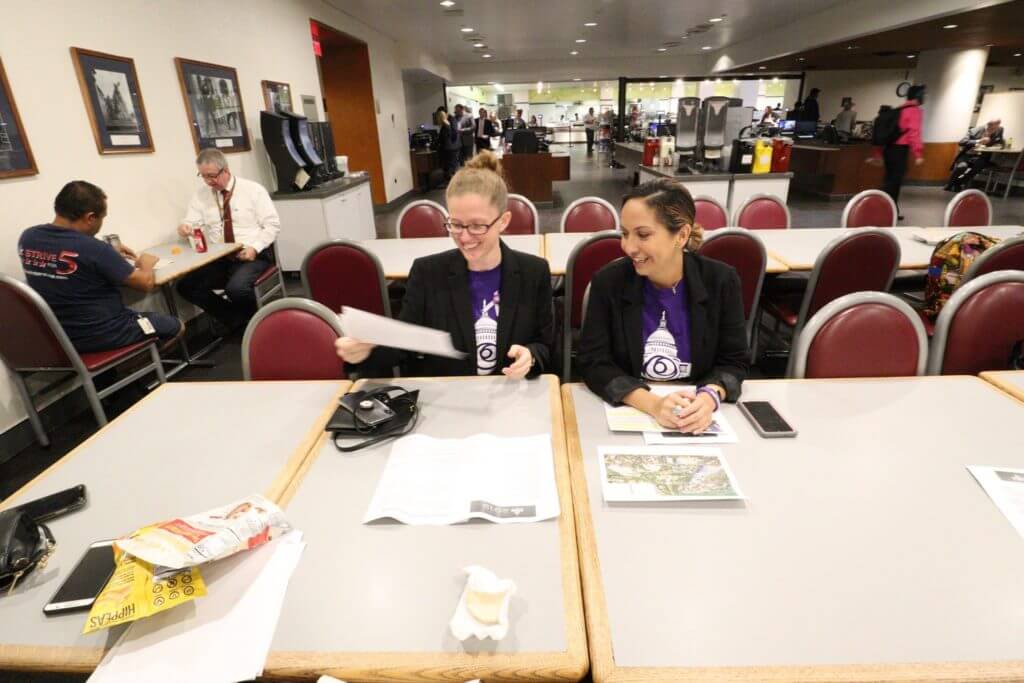Fibromyalgia Advocacy Day took place on September 19, 2019, on Capitol Hill in Washington, DC. This is one step of many to making positive, ACTIVE changes in the fibromyalgia community. Read on to find out what Fibromyalgia Advocacy Day is and the impact it’s having on the fibromyalgia community.

The Sun Shines on Possibilities
As the morning sun crept into the sky and the night faded into day, I watched the city slowly awaken. Excitement rose within me and my body was electrified by the exciting possibilities of the day’s events. Our hopes of taking action within the fibromyalgia community to make improvements in patient care, research funding, and education for medical providers was now a reality.

Fibromyalgia Advocacy Day had finally arrived. After months of planning, we (about thirty advocates and me) were finally on a shuttle heading to the hub of the country – Washington, DC – where we would be meeting with staff members from the Senate and House of Representatives to discuss the changes needed in the fibromyalgia community. We knew the significance of this day, and we were each determined to make the most of it.
While advocates around me nervously and excitedly chatted with one another, I reflected on how this moment arrived; thinking of all the steps in my fibromyalgia journey that have led me to this place amongst an inspiring group of individuals each having a unique story of how they arrived at this moment. It was an honor to have a place amongst them and to share in this experience.
My First Step Towards Advocacy
Looking back, I realize with every step I’ve taken since my onset of symptoms in 2006, I have been working towards this juncture. (Read my fibromyalgia story here.) Never in my wildest dreams did I ever imagined I would one day be standing in the Senate and House of Representative buildings as a fibromyalgia advocate and community leader asking for help from our states’ legislators.

My first step on the road to advocacy was starting a blog – this blog – in order to connect with other parents living with fibromyalgia while raising a family. I shared my experiences of struggling and figuring out how to best manage my symptoms while my little ones ran circles around me. It was me telling my story to others with the intention of shedding light on parenting with fibromyalgia and the hardships of it. Honestly, I had no intention of becoming an advocate, but it happened through my writing and connecting with others.
The next steps included were creating a fibro parenting group, sharing reliable resources with other fibromyalgia patients, and figuring out how to effectively make positive improvements with our quality of life. It’s never a completed task, that’s for sure. It’s an ongoing process with regular updates as new research and information become available on fibromyalgia.
Another HUGE step in the advocacy journey was connecting with Melissa Talwar and working with her to create the International Support Fibromyalgia Network. The day she and I met, we discussed the faults in the fibromyalgia community and the gaps where patients were falling through. We agreed that what the community really needed was ACTION. Active changes for patients and their families to receive what they were (and still are) desperately needing. Little did I know how this small, informal meeting would one day lead to Fibromyalgia Advocacy Day in our nation’s capital.

Awareness and Advocacy Work Together
Let me pause for a moment and talk about the importance of awareness and advocacy and how the two relate. Because you see – one cannot effectively work without the other. They go together like peanut butter and jelly – and the results are just as sweet.
Awareness is bringing attention to the issue at hand. In this case, fibromyalgia. Infographics, memes, and other visuals pepper social media platforms vocalizing the legitimacy of fibromyalgia and the impacts it has on individuals. More and more people are sharing their stories of diagnosis, the struggle of getting properly treated by medical providers, facing the stigma of being lazy or drug/attention seeker, and other issues we endure each and every day. Simply put, you are making someone AWARE of an issue.

Advocacy is publicly supporting a specific cause. Like awareness, this can come in various ways – working/volunteering with a nonprofit for that cause, speaking on behalf of someone in order to gain support, help raise money for a cause, and many other ways. In other ways, it’s the ACTION taken for a cause.
Awareness falls flat without advocacy. It’s like complaining about a problem (awareness) without creating solutions or making changes to rectify the problem (advocacy). And advocacy, in turn, cannot be effective without awareness. It’s the same as creating solutions to a problem (advocacy) without knowing what the problem is (awareness).
Fibromyalgia Advocacy Day 2019: Photos and Behind the Scenes
Origins of Fibromyalgia Advocacy Day
Fibromyalgia awareness has been prevalent over the decades. More and more people are speaking out about their condition, the comorbid conditions with it, struggles with symptoms, and other ways the condition affects their daily lives. It’s important to have these stories shared in order to give an idea of the seriousness of fibromyalgia (it’s a REAL issue) and to have information about it spread to others that do not know about it.
In order for that awareness to be meaningful and effective, advocacy must pick up the torch and carry it onward towards change. Awareness and advocacy are cyclical and continuous as an ongoing process of change. For this reason, the Support Fibromyalgia Network created a Fibromyalgia Advocacy Day at the Senate and House of Representatives in September.

The Core of Fibromyalgia Advocacy Day
The core reasoning of Advocacy Day was for fibromyalgia patients to meet with their state Senators and Representatives to tell them about fibromyalgia (awareness) and to ask for specific changes needed in the fibro community (advocacy). Since both houses of Congress were in session, state constituents (state residents) met with the Senators’ and Representatives’ staff members.
Each fibromyalgia thriver at the Capital had their own reasons for being in DC for Advocacy Day. Our stories vary, but the changes we asked for was common:
We need more defined diagnostic criteria in order to receive a quicker diagnosis to begin healing. More importantly, we need increased funding for medical research on fibromyalgia to receive better education for patients and providers and more effective alternative treatments.

About the Meetings with Staff
Honestly, I was nervous, scared, and intimidated to attend Advocacy Day. I had no idea what to expect when I got there or how staff members would receive my story and ask for support. Until that day, I really thought the staff would not care about what I had to say. I’m happy to say this was NOT the case at all. In fact, it was the opposite.
The first meeting of the day (we had six meetings total) was with South Carolina Senate staff member, John. Each meeting started with who I was, which district I lived in, and if he/she was familiar with fibro. After stating he wasn’t, I briefly explained what fibromyalgia is without getting into the complexities of it. (We could have been there all day if we explained it in its entirety).
My state representatives –
Contents of Each Meeting
Then I explained how I developed fibro and how it impacts my daily life and my family. It was also mentioned that the National Institutes of Health cut the research funding for fibromyalgia by $2 million for 2020. Immediately he asked why it was cut (which we had no answer) and then encouraged us to find out why it was cut. It would give us more insight into what was happening at the NIH.
I concluded by asking if the Senator would be able to support the request for increased funding of fibromyalgia research. His response was impressive. First, he expressed the importance of us visiting the Senate to make the Senators and staff more aware of the issues the constituents are experiencing with fibromyalgia and how the Senators can help (the italicized paragraph above). He said it’s helpful to know about it and what actions we are specifically seeking.

In addition, he encouraged us to look for bills or other documents specifically related to what we are asking and bring those to the attention of the staff. There are no guarantees to the outcomes, but it would be bringing it to their attention.
The other meetings for South Carolina and North Carolina (the Carolinas were teamed up) were just as encouraging and positive. There was great feedback about what we could do and how to go about it. The support was astounding and unexpected but fully welcomed.
The Takeaway of Fibromyalgia Advocacy Day
The key takeaway of Advocacy Day for me was this:
As a single person, our fibromyalgia journey is moving and meaningful. Collectively, our journeys are monumental and impactful.
This was certainly seen and felt during our time in DC. Throughout my time there, it occurred to me how much louder we can be when working together. It’s like Whoville in Horton Hears a Who (check out the clip below) when Horton is trying to save Whoville. It took all of Whoville to raise all of their voices at once in order to break the barrier (the clouds) and be heard by Horton’s world. This is exactly how I saw Advocacy Day – breaking barriers to be heard by those that can help us make a difference.
I had my doubts before attending Advocacy Day. Despite being a positive person, I didn’t think the staff would receive our message or be interested in what we had to say. This is one of the times I’m happy to say that I was wrong. Our Senators and Representatives WANT to hear from us. They want to know how they can help us help them.
Fibromyalgia Advocacy Day was a giant leap forward in my fibromyalgia journey and I look forward to more advocacy days in the future.
Want to learn more about Fibromyalgia Advocacy Day? Visit the International Support Fibromyalgia Network website.




